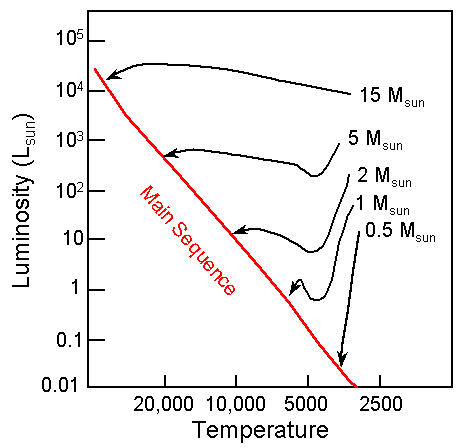

|
Astronomy 162:
Introduction to Stars, Galaxies, & the Universe
Prof. Richard Pogge, MTWThF 9:30
|
Lecture 14: Star Formation
Readings: Chapter 20
- Raw material of star formation: Giant Molecular Clouds
- Formation Stages:
- Cloud Collapse and Fragmentation into clumps
- Protostar formation from clumps
- Onset of Hydrostatic Equilibrium (Kelvin-Helmholz timescale)
- Ignition of core Hydrogen burning & onset of
Thermal Equilibrium
- Minimum & Maximum masses of stars
The Sun is Old and in Equilibrium
If we look at the Sun today, some 4.6 Gyr after it formed, we find
- It is in Hydrostatic Equilibrium: its internal Pressure and
Gravity are in balance, so it neither expands nor contract.
- It is in Thermal Equilibrium: Energy Transport balances Energy
Generation, so its energy lost by its Luminosity is
made up for by nuclear fusion energy generated in its core.
The big question is, how did it get this way?
Steps to Stardom...
Star birth is basically a 2-stage process:
- Establish Hydrostatic Equilibrium. This is the Protostar Formation phase
- Establish Thermal Equilibrium. This is the Pre-Main Sequence phase
The first question we have to ask is where stars are Born? We learn this
by looking around the Galaxy.
The Interstellar Medium
The space between the stars is filled with Gas and dust (fine particulates).
- Most of the volume is filled with hot, diffuse (very thin), atomic
Hydrogen gas
- Embedded within this are clumpy clouds of cold, dense Molecular
Hydrogen (H2) gas.
Young stars are all found in dense gas-rich regions.
This makes sense, since we expect to find new stars close to the raw
materials from which they are born.
Giant Molecular Clouds (GMCs)
Interstellar clouds of molecular hydrogen gas (H2)
Properties:
- Sizes: 10-50 parsecs
- Masses: ~105 Msun
- Temperatures: 10-30 K
- Densities: 105-6 molecules/cc
This is a starting density of ~1020 times smaller than that of a
star. This means the collapse from cloud to star has a long ways to go.
Collapse of a GMC
A GMC is held up against its own gravity by its internal pressure.
This pressure has 2 sources:
- Gas pressure from internal heat
- Pressure from embedded magnetic fields
If the Gravity becomes larger than the internal Pressure, the entire
cloud will start to collapse.
Possible ways to trigger such a collapse include:
- Cloud-Cloud collisions.
- Shocks from nearby supernova explosions
- Passage through a spiral arm of the Galaxy.
Cloud Fragmentation
GMCs are clumpy:
- Clump Sizes ~0.1 parsecs
- Clump Masses ~few Msun
High-density clumps are more unstable than low-density
regions:
- Densest clumps will collapse first and fastest
Result:
- GMC fragments into dense cores
- Cores have masses comparable to stars.
Building a Protostar
Cores start out low density and transparent:
- Photons can leak out, keeping the interior gas cool
- Can't build up pressure, and so keep collapsing
Eventually, the core density rises to the point where the core becomes
opaque:
- Photons get trapped, so the gas heats up
- Pressure begins to build up
Eventually, the pressures builds up until it achieves
Hydrostatic Equilibrium
Protostellar core continues to grow as fresh material from the
surrounding parent cloud falls onto it.
A Quick Beginning...
The protostar phase is very short-lived: only 104-5 years.
During this phase:
- The Protostar is in Hydrostatic Equilibrium
- It remain deeply embedded within their parent gas & dust cloud
- It is not yet in Thermal Equilibrium
The combination of "Short Lived" and "Hard to See" means that very
few Protostars are observed.
Protostars have Disks
As matter rains onto the Protostar,
- Matter along the poles free-falls in rapidly
- Matter along the equator will infall more slowly due to
angular momentum conservation.
The result is that the infalling gas pancakes, forming
a flattened, rotating disk around the equator of the Protostar.
Clearing out the Disk
After the protostar forms, the disk of material begins to clear away:
- Some of the matter drains onto the star
- Other bits form into planets
Observations suggest that:
- The gas in the disk clears away quickly, in ~6 Million years.
- The dust grains and solids (pebbles & rocks) take longer
We see dust and "debris" disks around young low-mass stars.
From Protostar to Star
Protostars shine because they are hotter than their surroundings:
- Need an energy source to stay hot, but
- Central temperature is too cool for nuclear fusion to ignite
Initial energy source is Gravitational Contraction (aka, the
Kelvin-Helmholz Mechanism):
- The Protostar shrinks slowly, releasing gravitational energy
- 50% goes into photons, and is radiated away as starlight
- other 50% goes into heating the Protostar interior
How long can does this last?
Kelvin-Helmholz Timescale
To understand how long a Protostar can shine by Gravitational
Contraction, we need to compare two numbers
The ratio is the Kelvin-Helmholz Timescale:

The Kelvin-Helmholz timescale is ~30 Myr for a 1 solar mass Protostar.
Consequences:
- Shorter K-H time for high-mass protostars
- Longer K-H time for low-mass protostars
H-R Diagram of pre-Main Sequence evolution for stars of various masses:

The K-H timescale is the time to cross the diagram and land on the
Main Sequence.
High-Mass Protostars
Gravitational Collapse is very fast for high-mass protostars:
- A 30 Msun Protostar will collapse in <10,000 years.
As the collapse proceeds, the core temperature gets hotter until
it reaches ~10 Million K:
- Ignites first P-P chain, then CNO cycle fusion in its hot core
The star lights up, quickly ionizing and blowing away any remaining
gas and junk.
Low-Mass Protostars
Gravitational Collapse is slower for low-mass protostars:
- 1 Msun Protostar takes ~30 Myr
- 0.2 Msun Protostar takes ~1 Gyr
When core Temperature >10 Million K:
- Ignite core P-P chain fusion
- Stellar wind blows away the cocoon and remaining disk
Settles slowly onto the Main Sequence
As the core heats up, H fusion runs faster:
- Core Temperature & Pressure rises
- Collapse begins to slow down
- Pressure = Gravity and core collapse stops
- Energy created by P-P chain fusion = Energy lost by shining (Luminosity)
Star reaches the Zero-Age Main Sequence as a full-fledged
star in Hydrostatic and Thermal Equilibrium.
Minimum Mass: ~0.08 Msun
Below 0.08 Msun, the core never gets hot enough to ignite H
fusion.
Object becomes a Brown Dwarf
- Resemble "Super Jupiters" in their properties.
- Generate energy by the Kelvin-Helmholz mechanism
- Only a few hundred are known (very faint)
- Shine mostly in the infrared
These are the T dwarfs.
[Hubble Space
Telescope images of the Brown Dwarf Gliese 229B]
Maximum Mass: 100-150 Msun
Above a mass of 100-150 Msun, the core gets so hot
that
- Radiation pressure overcomes gravity,
- Star becomes unstable & disrupts itself
The ultimate upper mass limit is not well known.
Such stars should be (and are) extremely rare (a few per galaxy).
[Hubble Space
Telescope images of a very luminous star]
What can we see?
As we look out into the Galaxy, we see stars in all phases of their
life cycles:
- If the phase is long-lived, we see many stars in that phase
- If the phase is very short, we see only a few stars in that phase
The Pre-Main Sequence phase is longer for lower-mass stars
(because of the longer K-H timescale):
- We see a few low-mass Protostars
- High-Mass Protostars are very rare
The Main Sequence Phase is very long:
- We see more M-S stars than Protostars by far
How long is the M-S phase? That's the subject of the
next lecture...
Return to [
Unit 2 Index
|
Astronomy 162 Main Page
]
Updated: 2006 January 21
Copyright © Richard W. Pogge, All Rights
Reserved.



